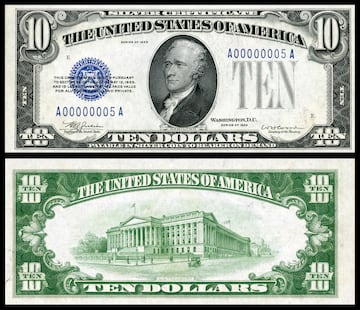These are the $10 bills that can be worth up to $70,500 | How to know if you have one
Collectors are willing to dish out vast sums of cash to get their hands on the rarest of the rare. A $10 bill from the Great Depression is one of them.

Digging through collections of remembrances stored in attics, garages, storage sheds and so forth, you may come across something valuable. Not just sentimentally, but worth some real mula. With the right eye, and knowledge of what you are looking at, you may find old stamps, coins or bills that, while on face value seem almost worthless, are in fact coveted by collectors who will pay wads of cash.
So that brings us to 1933. What a year… That infamous year, besides events taking place outside of the United States, was the deepest depths of the Great Depression. Unemployment hit its worst level that has ever been recorded.
The newly elected US President, Franklin D Roosevelt, and his administration were trying to put the nation on to a path of recovery. Part of that plan was to shore up the finances of the Federal Reserve which was reaching its limits of reserves to back the ‘Greenback’. While officially the US has never defaulted on its debt, FDR signed Executive Order 6102 to " prohibit the hoarding of gold coin, gold bullion, and gold certificates within the continental United States.” Thus, the nation overtly defaulted on its gold bonds backed by the “full faith” of the nation.
“The King of Silvers,” $10 bills that can be worth up to $70,500
That piece of paper which was supposed to be backed by a precious metal wasn’t the only one that had to go. In 1933, the US Treasury printed the what is called “The King of Silvers.” These particular $10 silver certificate bills that came off the mints presses that year, “might be called the holy grail for some collectors,” says Andrew Adamo, the vice president and co-founder of Bullion Shark.

The printing run was limited to just one year, only 216,00 were produced. A mere 156,000 made it to the streets, and the remaining certificates were destroyed. Then an active campaign was put into place to retrieve those that had gotten out into the public’s hands. In 1944, the US Secret Service opened an investigation to recover those still in private hands, managing to scoop up most of them. However, “though these certificates are illegal to own, there is a possibility that a few are still in private hands,” says Adamo.
Thus, they are highly valued. A “King of Silvers,” should you be lucky enough to come across one in your attic or somewhere else, could fetch you up to $70,500. That is, if it is in the “finest” of conditions. Those that have been found of “fairly good condition” in the past have gone for $5,200. Still, not an amount of money to just shrug off.
How to know if you have a $10 bill worth up to $70,500
According to Adamo, there are certain features that will differentiate a regular $10 bill from a “King of Silvers.” One feature to look out for is that it will state at the bottom, “Payable in Silver Coin to Bearer on Demand” and not “Silver Payable to the Bearer on Demand.” A slight play of linguistics but could be the difference between tens of dollars and tens of thousands of dollars.
Here are some other features that you want to be on the look out for:
- Bears Andrew Hamilton’s face
- Displays the Silver Certificate across the top
- The date of 1933 will appear on the certificate
- Signature combination of both WA Julian and WH Woodin
- The serial numbers are always in blue ink, this will make them stand out next to the large seal reading “TEN” on the bill’s righthand side
And should all the above coincide you may have a $10 bill worth up to $70,500. However, before you go counting your chickens before they hatch, Adamo recommends having “any of these bills authenticated by a numismatist or other currency grading service.”
So, who ever said a little spring cleaning doesn’t pay off. Happy hunting!






